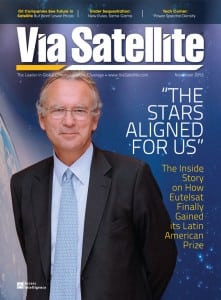Latest News
Via Satellite November: The 10 Best Quotes
In the November issue of Via Satellite magazine, we learn the inside story behind Eutelsat’s strategy for Latin America, the oil and gas industry’s perception of the HTS market and their demands for a right price, and we see how the government approaches business with satcoms under the thumb of sequestration. As a teaser to this edition, we bring you the 10 best quotes you will read in it:
When talking to satellite providers, they still appear to be masked in secrecy in terms of the bandwidth costs or the satellite space segment costs. Those aren’t clear and I don’t believe we are seeing transparency in this area. – Ian Theophilus, general infrastructure manager, Tullow Oil
Ka-band MEO satellites could very well be a boon for the industry; we will likely know more after providers have established satellite constellations next year. – Donald Happel, field telecoms advisor, Americas infrastructure projects, Shell Information Technology International
Satellite solutions will remain very important to us, as much as they have been in the past. Petrobras has an optical fiber ring of 500 km in the Campos Basin connecting several rigs. This ring may be extended for other units in the future, but it depends on the business evolution and the economic feasibility. We expect providers of satellite communications solutions [to offer] higher performance and low delay in communication, and mainly, lower prices. – Firmiano Ramos Perlingeiro, head of Information and Communications Technology (ICT), Petrobras
[The] shale gas play in North America continues to have a need for satellite communications, and a European shale-gas play could be on the horizon depending on the regulatory environments. Longer-term, Asia- Pacific and East-Africa show signs of an increased need for satellite communications as more seismic surveys are done in the areas, and more viable discoveries are made. Combine that, with relatively under-developed infrastructure and they are prime for increased opportunities for satellite communications. – Brad Grady, analyst, NSR
The DoD is being forced to do more with less. The type of traffic that’s being transmitted over satellite is changing. There’s still a good amount of voice and data but the percentage of video is increasing. – Karl Fuchs, VP of technology, iDirect Government Technologies
In the next three to five years, we’ll see significant erosion of [bandwidth] prices. Demand will drop in shifts. It will change the whole dynamic between the satcom industry and government. – Philip Harlow, president and COO, XTAR
We all want to ensure that the capabilities that the warfighter requires are provided at a best value price. Budget cuts are driving down prices but, at the same time, not maintaining or increasing the value or capability that the warfighter needs. – Rebecca Cowen-Hirsch, senior vice president, government strategy and policy, Inmarsat
[Air Force’s Wideband Global Satcom system] has got more capacity than any previous generation of government-owned system. That will have a big effect on the degree of DoD’s commercial spending in the next few years. – Tim Farrar, president, TMF Association
Lets face it, for Eutelsat, Latin America had been a dream. We were basically an invisible player. We had one sales person and a marginal business. Other options seemed difficult. Abertis-owned Hispasat was not really on the table nor was Star One, the great Brazilian operator. … I felt [Satmex] was more of a priority for us than for other players. … For us, it was a perfect fit. For others, it would have been more opportunistic rather than strategic. – Michel de Rosen, CEO, Eutelsat
The growth prospects for Satmex should be materially higher than for Eutelsat as a whole, in our view. Firstly, demand in the Latin American region, which is the focus of Satmex’ business, is forecast to be materially higher than that of EMEA, which is the main area of Eutelsat’s existing operations. Secondly, Satmex capacity is set to more than double over the next few years, but the incremental capital cost to Eutelsat will be quite limited, given that the satellites that are due to be launched will be pretty low cost relative to Eutelsat’s “normal” satellites, and also largely paid for already. – Sarah Simon, senior analyst, media, Berenberg Bank
Click here to read the November issue of Via Satellite right on your desktop for free!
Get the latest Via Satellite news!
Subscribe Now